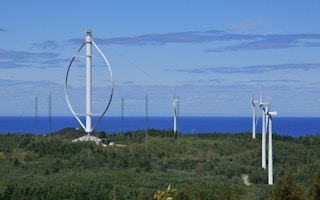Walking around Rome, famously not built in a day, I was struck by the contrast between today’s accelerated timescales and the slower rhythms in the rise, decline, fall and (sometimes) rebirth of businesses, economies, societies and civilizations.
I was in the Eternal City for a J.P. Morgan philanthropy event, where participants discussed how to create, measure, value and reward new types of impact. (To be clear, I was there as a speaker, not as a representative of the three-yachts-per-family global elite.
In the wider world, meanwhile, the evidence of economic disruption—and of the waning of an old economic order—was swirling all about us. Let’s pick just three energy sector straws in the proverbial wind: the Chapter 11 bankruptcies of Peabody Energy and SunEdison, and the announcement of plans for a staggeringly ambitious economic pivot by Saudi Arabia.
Few companies were as ‘Old Order’ as Peabody Energy, the world’s largest privately held coal company. True, it had been trying to position coal as the answer to the global poor’s energy prayers, but the direction of history is clear. China is using less coal, President Obama is pursuing what coal enthusiasts dubbed his “War on Coal,” and last year’s COP21 summit saw the industry flagged as most-likely-to-fail in the new energy order.
In terms of companies most likely to succeed in the New Order, Bloomberg’s recent New Energy Finance Global Summit spotlighted four golden sectors: renewable power, energy storage, electric vehicles and smart grids. Those were the sectors that most excited participants, according to Bloomberg New Energy Finance chief editor Angus McCrone.
As McCrone noted: “Like the U.S. government triangle of executive, legislature and judiciary, the four energy corners are all linked to each other. They make it possible for each other to do new things—without EVs, for instance, battery storage would not be enjoying such improvements in its cost-effectiveness, and without renewables, the opportunity of an intelligent grid would be low-priority. Without new grid technology, storage, EVs and renewables would find their headroom limited.”
He then queried whether, could “the sector be getting ahead of itself? Could the unambiguously upbeat mood at the 2016 Summit—exemplified by the excited hubbub in plenary sessions, the innumerable confabs in networking areas, the throngs packed in like sardines at the most topical break-outs (yes, I was at the large-scale solar session!)—give way to a new round of worries in the year ahead?”
It could. McCrone had mentioned “the crisis” at SunEdison. When I picked up The International New York Times on April 25, the first paragraph of an article on the renewables sector read: “It was just last summer that SunEdison was a Wall Street darling, the very air around the fast-growing company seemed to shimmer with potential. SunEdison was, after all, a red-hot company in a red-hot space—renewable energy.”
“
The signs are that the old energy order is coming apart at such a rate that those who want to build the new order will need to step on whatever will substitute for the gas.
But the company had gone “super-nova,” its shares falling from $32 last summer to 34 cents on April 20. It declared Chapter 11 bankruptcy on April 21, the biggest bankruptcy the renewables world has yet seen. Interestingly, as the Financial Times observed the next day, SunEdison did not have any clear technological advantage. Instead, it focused on what its CFO had described as “capital innovation.”
One key factor in the collapse, we were told, was “the complexity of SunEdison’s business model, with three linked companies plus numerous other related vehicles, including special project financing ‘warehouses,’” which made it much harder for investors to understand what was going on. Although the company’s motto was “Simplifying Solar,” its corporate structure had gone in the opposite direction.
SunEdison, its CEO had claimed, would be the ExxonMobil of solar. (Interestingly, a few days after SunEdison filed for bankruptcy, Standard & Poor’s stripped Old Order ExxonMobil of its coveted AAA status, downgrading it to AA+ because of continuing low world oil prices.)
Ancient Romans would now open up a sacrificial animal or two to get a sense of where the world may be headed, but we have come to rely on different augurs.
Though some analysts may read the Peabody Energy and SunEdison filings as cancelling each other out, the scale of the energy transition now coming our way was again underscored in April when Deputy Crown Prince Mohammed bin Salman announced his plans to prepare Saudi Arabia for the end of the oil era.
In eight “unprecedented” hours with Bloomberg’s Peter Waldman, the “power behind the world’s most powerful throne” explained his generation’s “different dreams.” He then unveiled his Vision for the Kingdom of Saudi Arabia, “an historic plan encompassing broad economic and social changes.
It includes the creation of the world’s largest sovereign wealth fund, which will eventually hold more than $2 trillion in assets—enough to buy all of Apple, Google, Microsoft, and Berkshire Hathaway, the world’s four largest public companies.”
Whatever we may think of Saudi Arabia, this sounds seismic—though some observers are skeptical. As The Economist commented, the assumption is “that the kingdom could overcome ‘any dependence on oil’ within a mere four years, by 2020.
That may have been meant to convey a sense of urgency,” the magazine noted, “but it also sums up what seems to be manic optimism among the youthful new policy-setters of the royal court.”
To people stuck in the world of what Alex Steffan dubs “predatory delay”, attempts to move economies onto different—exponentially different—trajectories will always seem manic.
But the signs are that the old energy order is coming apart at such a rate that those who want to build the new order will need to step on whatever will substitute for the gas. It’s a race between breakdown and breakthrough.
John Elkington is chairman and chief pollinator, Volans.


















